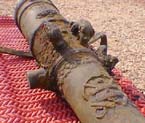| Probably about 99% of Florida's archaeologists and historic preservationalists think that the
State of Florida's salvage policies (allowing treasure hunting of historic sites for the profit of
private individuals) to be very bad for the cultural resources and the people of Florida. I think
it is preposterous to propose that the state has benefited from the salvage activities that have
occurred.
Many, many shipwrecks have been destroyed by these activities, with little or no documentation produced, e.g. the wrecks of the 1715 and 1733 flotas. Much information has been lost in the process, not to mention 75% of the artifacts. The destruction/lack of reporting was certainly worse in the past, but the quality of the reports produced generally does not come anywhere near to many reports produced by qualified (and not-for-profit) archaeologists. Again, for an example of a good report, take a look at either of the Emanuel Point shipwreck publications that the state of Florida has produced. If all treasure hunters put that kind of effort into doing methodologically sound excavation/data recovery and producing that kind of report, it would be a lot harder to complain about them. In my opinion, it would be laughable to use Florida's failed shipwreck mangement program as a model for any cultural resource mangement policy. The case of San JosťFor example, take the San Josť, one of the 1733 flota ships that was lost in the Upper Florida Keys. It was discovered by salvor Tom Gurr. Talking to folks who were the first to dive on the site in 1968, it is obvious that that wreck is pretty much destroyed as it exists today. At that time, decks were intact, with all kinds of packaged cargo still in place as it was origianlly laded. This could have been recorded to the meticulous detail that was done, say, on the recent Belle shipwreck in Texas. Instead, it was taken apart with not too much regard for mapping or recording. Apparently some folks even used dynamite to disarticulate hull timbers. There certainly exists no rich documentary report, such as the Emanuel Point reports. So that is what I meant by many wrecks being destroyed. If archaeologists had excavated those wrecks, then a suitable product would have been required, or else that scientist could never get a research permit again.
Not ALL information is lost on salvaged sites, just most of it. Archaeologists have been able to come in behind the salvers in many cases and record the site as it appears after salvage activities, and this often produces some very worthwhile data. An example are the efforts of Dave Moore on such sites as the Wedge Wreck (1715). Still, because the original archaeological context of the site has been seriously impaired, these efforts cannot compare to a more-or-less pristine site excavated using the techniques developed by modern archaeologists (again, compare to the information gathered from the Emanuel Point wreck). Most salvers, for example, don't bother screening bilge sediments through 1/32" screen, in order to gather teeny tiny little things like botanical and insect remains. These kinds of things can generate a lot of interesting data about past lifeways and maritime trade, and are normally collected by archaeologists, but we of course have no comprable data from the wrecks of the 1715 and 1733 flotas. 75% lostBy 75% of the artifacts being lost, I refer to the standard division in the legal system of commercial salvage in Florida. 75% of the artifacts are kept by the salver, and thus by definition are "lost" – before the salvage the public owned 100% of the submerged artifacts, afterwards, only 25%. In most cases these are sold to in an attempt to make a profit or pay accounts, so that they may never be seen again by the general public. Of course in rare cases, the salver does retain some of the 75% for a private museum-type display, as is the case with the Mel Fisher Museum in the Keys (which I really enjoy visiting, despite the less-than-scientific Atocha excavation it symbolizes). But for the most part the collection from any 75% split is disasembled and cannot be studied by any future researcher in any practical way, and is generally not available for public perusal. Program Assistant May 1999 Opinions expressed here are personal, not representing anything else. |

 Back to Nordic Underwater Archaeology
Back to Nordic Underwater Archaeology